3 November 2017
Trip to the mussel test farm in Greifswald Bay
There is a video from this trip available here
3 November 2017
Trip to the mussel test farm in Greifswald Bay
The mussel test farm, which was established in April in Greisfwald Bay, was once again visited by a team of German scientists (Anna-Lucia Buer, René Friedland and Lisa Meyer), who were accompanied by newly arrived Arrigo Pinsuti, IVY Interreg Project Partner at EUCC-D. Main focus of the trip was to check the current growth status of the farm (fortunately the whole farm showed no damage after the area was battered by gale-force gusts over the last days of October) and the mussels (they are still growing and replace more and more barnacles J). Further, we did some minor adjustments to the lines, partly buoys were added. Two longlines were lowered down by adding concrete blocks, so that the collectors will not be damaged by drifting ice.
Water samples were taken for Chlorophyll a and dissolved nutrients analyses. Water transparency was measured at 3.4 m, which is more than two times deeper than in summer. Water temperature was around 10°C.

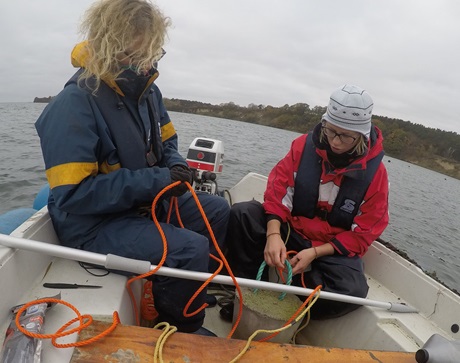
20-23 September 2017
Water clarity measurements: in situ sampling and satellite image collection
The Institute of Oceanology (IOPAN) team including Slawomir Sagan, Monika Zabłocka, Piotr Kowalczuk, Karolina Borzycka and Tomasz Krawczyk came to Denmark to realize some in-situ mapping of particle and fluorescence depletion around the mussel farms on scales down to 1 m during two field campaigns. The goal of the exercise was to take complete set of optical parameters of water as well as water constituents affecting underwater optics; outside and inside of the farms.
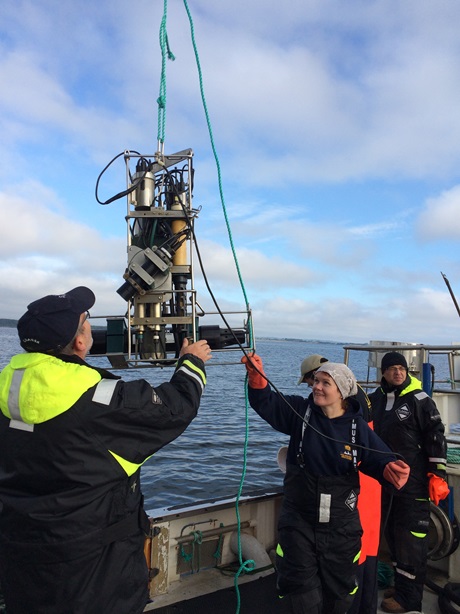
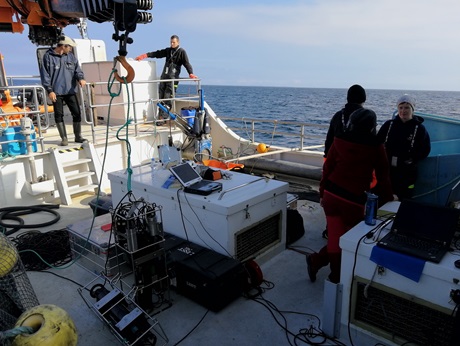
Altogether the IOPAN team sampled at 21 locations; 14 in Horsens Fjord in two runs, 20th and 21st of Sept and 7 in Limfjorden on sites 112, 193 and 61G, on 23rd of Sept. The measured parameters included profiles of water spectral optical properties (light attenuation, absorption, backscattering), particle size distribution (range 1-250 um), underwater lightfield, water incoming and outgoing radiance and irradiance, CDOM, FDOM and chlorophyll fluorescence. The matching water samples were taken which will be analyzed for chlorophyll, pigments (HPLC) , CDOM, FDOM contents and SPM. As planned, satellite imagery was collected in days prior to and during the in situ measurements. Technically and logistically all went smoothly, and IOPAN thanks for cooperation and great assistance they have experienced from the DTU Aqua team including Daniel Taylor and Niels Peter Nielsen.

18 September 2017
Social acceptance and Stakeholder involvement
Nardine Stybel (EUCC - The Coastal Union Germany) and Lars Kjerulf Petersen (Aarhus University) met in Warnemuende to plan next tasks on the topic social acceptance and stakeholder involvement. The BONUS-OPTIMUS project partners discussed contents of the questionnaire campaign of summerhouse owners to be conducted in the case study areas in 2018.
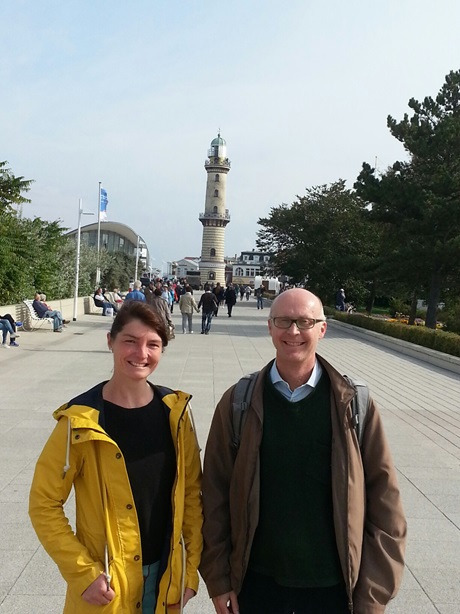
30 August 2017
Mussel test farm in Greifswald Bay
After having installed the mussel test-farm in Greifswald Bay in spring, the German mussel farm team has been waiting and hoping that enough larvae would settle on the collectors. Now after 3 months we can say, "Hurray, the larvae have settled and they are growing", we even had to add buoys to keep the collectors floating. Examinations of the collectors in July and August revealed that there is a dense settlement of Mytilus spp. on the collectors, although the larvae have to struggle with lots of barnacles. We are looking forward to the coming months too see if the success continues.
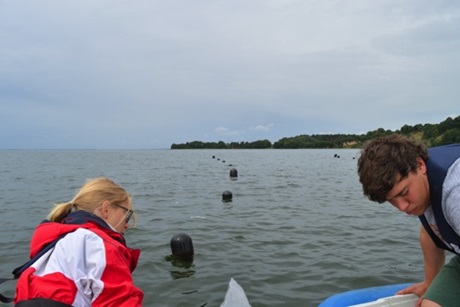
Anna-Lucia Buer from IOW – Leibniz Institute for Baltic Sea Research, Warnemünde and Lukas Rotzenhofen from Rostock University are preparing for inspection of the spat collectors.
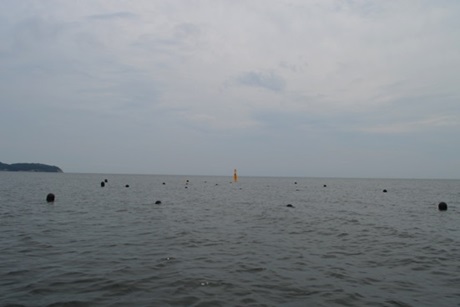
The mussel test farm in Greifswald Bay – a low saline area, where mussel growth is expected to be less than in the three other BONUS-OPTIMUS mussels farms located in the Limfjorden and Horsens Fjord, Denmark and Tjärnö, Sweden, where the salinity is higher.
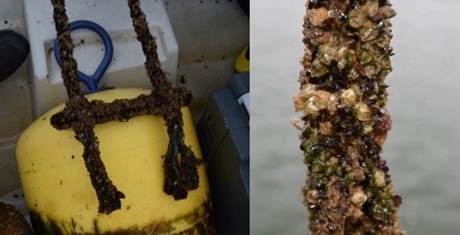
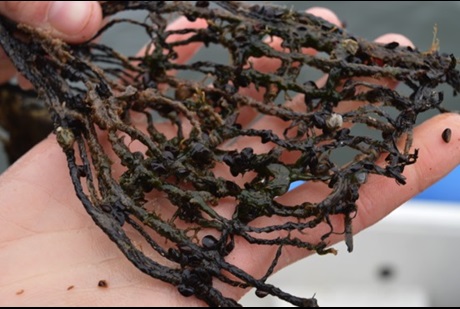
Different spat collectors were deployed in Spring 2017 and Mytilus spp. larvae have settled on the different types – along with barnacles.
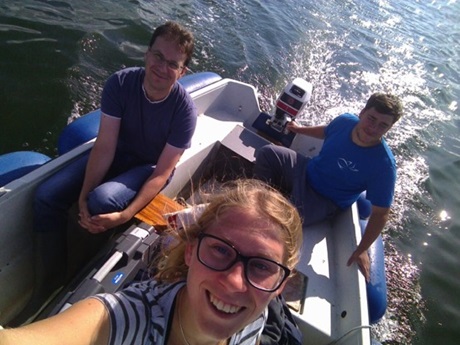
A happy German research team after a visit at the test farm in Greifswald Bay. From the Left: René Friedland, Anna-Lucia Buer and Lukas Rotzenhofen.
26 June 2017
Benthic Landers deployment in Horsens Fjord
This week, at a smartfarm mussel farm near Horsens Fjord, BONUS OPTIMUS researchers from DTU Aqua and UGOT (University of Gothenburg, Sweden) are deploying sophisticated benthic incubation chambers utilizing 15N tracing methods to characterize denitrification, DRNA (dissimilatory reduction of nitrate to ammonium), fluxes of nitrogen and phosphorous, dissolved oxygen, nutrients and carbon in the benthos. Sedimentation traps, sediment core samplers, and further environmental sampling are also being deployed during this campaign. As of today, two separate deployments have been successfully completed; now onto the analytics. These efforts provide an opportunity to elevate our comprehension of the complex dynamics of mussel farm nutrient immobilization and assimilation, as well as the scale of impact on sediment nutrient processing. Deposition of organic material onto the benthic surface, shifts in benthic biogeochemical regimes, immobilization of phytoplankton, and remineralization kinetics are crucial processes to describe when evaluating the extent to which mitigation mussel farming may influence aquatic ecology and water quality. Follow-up campaigns are planned for later in the year following the growth of mussels in the farm to track sediment impacts.
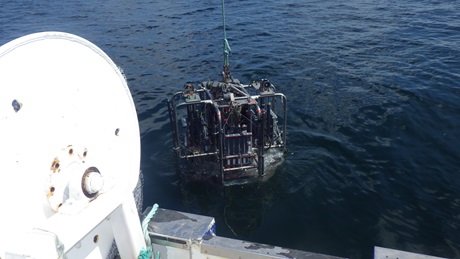
Four chamber benthic lander being deployed

15N injection stage and sampling stages. Every few hours, water is sampled from the incubation chamber to track flux processes. Sediment can also be captured on recovery
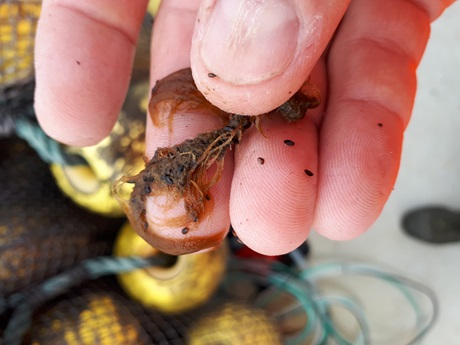
Juvenile mussels interspersed among the growth on the nets
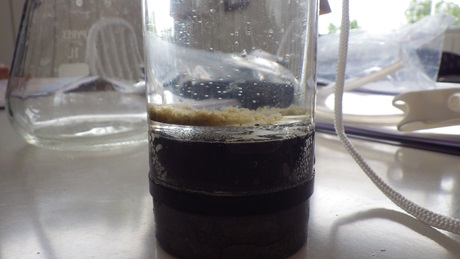
Captured material bound for the benthos. Sediment traps were deployed above the sediment surface to forgo interference from potential resuspension

Core samples. Benthic primary production was observed in both the farm and reference site
8 June 2017
Deployment and environmental monitoring
The BONUS OPTIMUS smartfarm nets have been deployed in the Danish site in Horsens Fjord. Plankton and water samples have been taken at the same time.
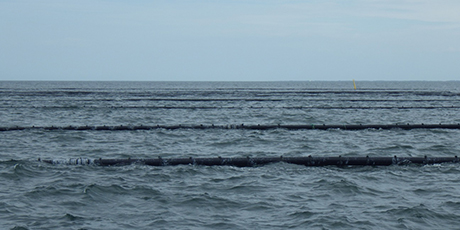
Horsens farm: deployed smartfarm tubes.
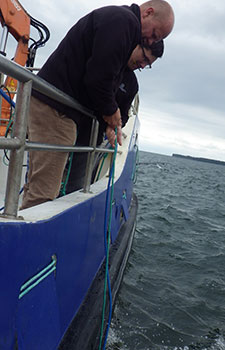
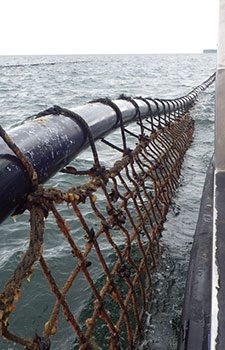
Left: Horsens Fjord: Professor Jens Kjerulf Petersen and PhD Student Daniel Taylor, Danish Shellfish Centre casting a CTD (Conductivity, Temperature, Depth) next to the smartfarm tubes from Hjarnø Havbrug A/S’s vessel Thor.
Right: Example of net attached to the smart farm tubes.
24-25 April 2017
Project kick off meeting
The OptiMus consortium meets for the project kick off seminar at Danish Shellfish Centre on 24-25 April. Twenty participants from seven research institutions and two companies will attend the meeting.
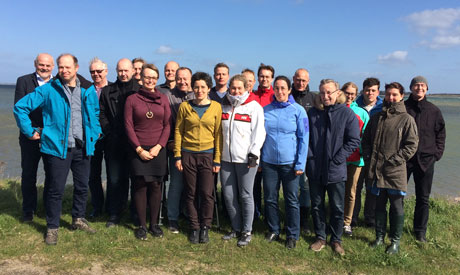
19-21 April 2017
Field work in Germany
IOW (Leibniz Institute for Baltic Sea Research) sets up a mitigation farm in Greifswald Bay in Germany assisted by a technician from DTU Aqua.

Click to see more pictures from the field work
1 April 2017
OPTIMUS project starts
The three-year BONUS project OptiMus (Optimisation of mussel mitigation cultures for fish feed in the Baltic Sea) starts. The project includes partners from Denmark, Germany, Poland and Sweden and is coordinated by Danish Shellfish Centre, DTU Aqua.Total budget is 2,9m EUR.
More BONUS OPTIMUS news